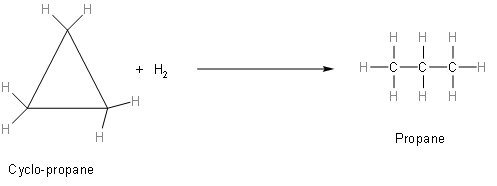
Consider the following two reactions:
i. Propene +${{H}_{2}}$→ Propane, $\Delta {{H}_{1}}$
ii. Cyclo-propane +${{H}_{2}}$→ Propane: $\Delta {{H}_{2}}$
Then, ΔH2−ΔH1 will be:
(A) 0
(B) $2{{(B.E)}_{C-C}}-{{(B.E)}_{C=C}}$
(C) ${{(B.E)}_{C=C}}$
(D) $2{{(B.E)}_{C=C}}-{{(B.E)}_{C-C}}$
Answer
216.3k+ views
Hint: First write down the reactions and their enthalpies in terms of bond energy. The energy for each type of bond is different, like B.E. for C-C, B.E. for C-H and B.E. for C=C will be different from each other but all C-H bonds will have the same bond energies. So, for each compound count the number of bonds for each type and write their enthalpies. Now subtract the enthalpies of both the reactions.
Complete step by step solution:
So, first of all, we have to write a reaction. And from that, we will find the number of bonds of different bond energy. The reaction of hydrogenation of propene and hydrogen is as follows.

The above reaction is the hydrogenation of propene into propane. Now we will write enthalpy in terms of bond energy.
\[\begin{align}
& \Delta {{H}_{1}}=\sum{(B.E}{{)}_{reac\tan ts}}-\sum{(B.E}{{)}_{products}} \\
& \Delta {{H}_{1}}=6{{(B.E)}_{C-H}}+{{(B.E)}_{C-C}}+{{(B.E)}_{C=C}}+{{(B.E)}_{H-H}} \\
& \,\,\,\,\,\,\,\,\,\,\,\,\,\,\,-8{{(B.E)}_{C-H}}-2{{(B.E)}_{C-C}} \\
\end{align}\]
From the above equation we can say that, 6 denotes the number of hydrogen single bonds, whereas, in propene there is one single C-C bond and one carbon double bond. Whereas, on the product side, we have eight carbon hydrogen single bonds and two carbon-carbon single bonds. Now, we will further simplify the above equation.
\[\,\,\Delta {{H}_{1}}\,\,\,={{(B.E)}_{C=C}}+{{(B.E)}_{H-H}}-{{(B.E)}_{C-H}}-{{(B.E)}_{C-C}}\]
So, the above equation represents the enthalpy of reaction in terms of bond energy.
Now, in the same way, we will write the equation of cyclo-propane.

The above figure represents the hydrogenation of cyclopropane into propane.
\[\begin{align}
& \Delta {{H}_{2}}=\sum{(B.E}{{)}_{reac\tan ts}}-\sum{(B.E}{{)}_{products}} \\
& \Delta {{H}_{2}}={{(B.E)}_{C-C}}-{{(B.E)}_{C-H}}+{{(B.E)}_{H-H}} \\
\end{align}\]
This above equation represents hydrogenation of cyclopropane.
Now, we should calculate the difference in enthalpy in terms of bond energy.
\[\Delta {{H}_{2}}-\,\Delta {{H}_{1}}\,={{(B.E)}_{C-C}}-{{(B.E)}_{C-H}}+{{(B.E)}_{H-H}}-{{(B.E)}_{C=C}}+{{(B.E)}_{H-H}}-{{(B.E)}_{C-H}}-(B.E)\]
\[\Delta {{H}_{2}}-\,\Delta {{H}_{1}}=2{{(B.E)}_{C-C}}-{{(B.E)}_{C=C}}\]
Now, we can say that option B is the correct answer.
Note: We should now know about bond energy. We should know that bond energy (E) is defined as the amount of energy, which is required to break apart a mole of molecules into its component atoms. It is a measure of the strength of a chemical bond. Bond energy is also known as bond enthalpy (H) or simply as bond strength.
Complete step by step solution:
So, first of all, we have to write a reaction. And from that, we will find the number of bonds of different bond energy. The reaction of hydrogenation of propene and hydrogen is as follows.

The above reaction is the hydrogenation of propene into propane. Now we will write enthalpy in terms of bond energy.
\[\begin{align}
& \Delta {{H}_{1}}=\sum{(B.E}{{)}_{reac\tan ts}}-\sum{(B.E}{{)}_{products}} \\
& \Delta {{H}_{1}}=6{{(B.E)}_{C-H}}+{{(B.E)}_{C-C}}+{{(B.E)}_{C=C}}+{{(B.E)}_{H-H}} \\
& \,\,\,\,\,\,\,\,\,\,\,\,\,\,\,-8{{(B.E)}_{C-H}}-2{{(B.E)}_{C-C}} \\
\end{align}\]
From the above equation we can say that, 6 denotes the number of hydrogen single bonds, whereas, in propene there is one single C-C bond and one carbon double bond. Whereas, on the product side, we have eight carbon hydrogen single bonds and two carbon-carbon single bonds. Now, we will further simplify the above equation.
\[\,\,\Delta {{H}_{1}}\,\,\,={{(B.E)}_{C=C}}+{{(B.E)}_{H-H}}-{{(B.E)}_{C-H}}-{{(B.E)}_{C-C}}\]
So, the above equation represents the enthalpy of reaction in terms of bond energy.
Now, in the same way, we will write the equation of cyclo-propane.

The above figure represents the hydrogenation of cyclopropane into propane.
\[\begin{align}
& \Delta {{H}_{2}}=\sum{(B.E}{{)}_{reac\tan ts}}-\sum{(B.E}{{)}_{products}} \\
& \Delta {{H}_{2}}={{(B.E)}_{C-C}}-{{(B.E)}_{C-H}}+{{(B.E)}_{H-H}} \\
\end{align}\]
This above equation represents hydrogenation of cyclopropane.
Now, we should calculate the difference in enthalpy in terms of bond energy.
\[\Delta {{H}_{2}}-\,\Delta {{H}_{1}}\,={{(B.E)}_{C-C}}-{{(B.E)}_{C-H}}+{{(B.E)}_{H-H}}-{{(B.E)}_{C=C}}+{{(B.E)}_{H-H}}-{{(B.E)}_{C-H}}-(B.E)\]
\[\Delta {{H}_{2}}-\,\Delta {{H}_{1}}=2{{(B.E)}_{C-C}}-{{(B.E)}_{C=C}}\]
Now, we can say that option B is the correct answer.
Note: We should now know about bond energy. We should know that bond energy (E) is defined as the amount of energy, which is required to break apart a mole of molecules into its component atoms. It is a measure of the strength of a chemical bond. Bond energy is also known as bond enthalpy (H) or simply as bond strength.
Recently Updated Pages
JEE Atomic Structure and Chemical Bonding important Concepts and Tips

JEE Amino Acids and Peptides Important Concepts and Tips for Exam Preparation

Electricity and Magnetism Explained: Key Concepts & Applications

Chemical Properties of Hydrogen - Important Concepts for JEE Exam Preparation

JEE Energetics Important Concepts and Tips for Exam Preparation

JEE Isolation, Preparation and Properties of Non-metals Important Concepts and Tips for Exam Preparation

Trending doubts
JEE Main 2026: Application Form Open, Exam Dates, Syllabus, Eligibility & Question Papers

Derivation of Equation of Trajectory Explained for Students

Hybridisation in Chemistry – Concept, Types & Applications

Understanding the Angle of Deviation in a Prism

Understanding Collisions: Types and Examples for Students

How to Convert a Galvanometer into an Ammeter or Voltmeter

Other Pages
NCERT Solutions For Class 11 Chemistry Chapter 7 Redox Reaction

JEE Advanced Marks vs Ranks 2025: Understanding Category-wise Qualifying Marks and Previous Year Cut-offs

NCERT Solutions ForClass 11 Chemistry Chapter Chapter 5 Thermodynamics

Thermodynamics Class 11 Chemistry Chapter 5 CBSE Notes - 2025-26

Equilibrium Class 11 Chemistry Chapter 6 CBSE Notes - 2025-26

Ideal and Non-Ideal Solutions Explained for Class 12 Chemistry




